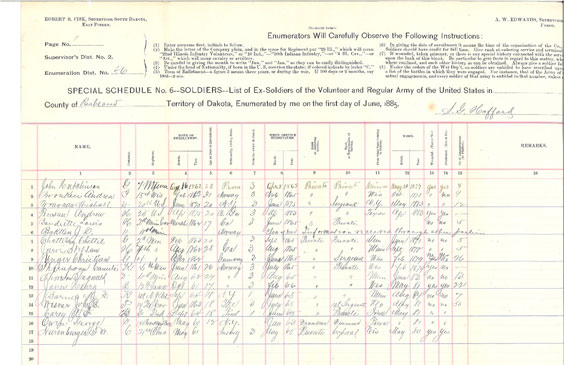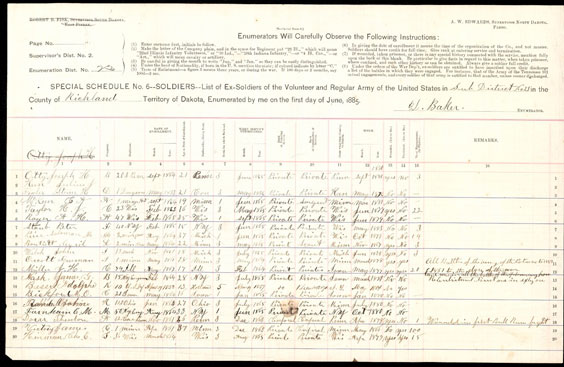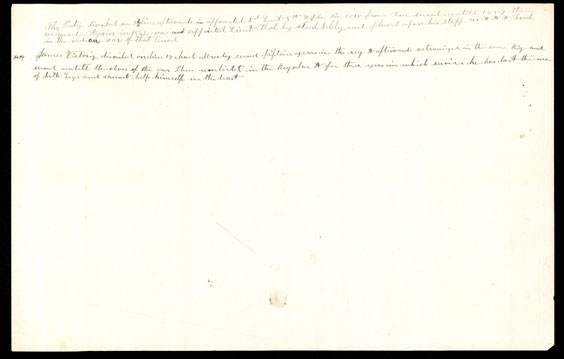Discovering North Dakota’s Civil War Veteran Pioneer Settlers: A Case Study in Richland County
Genealogy research is a significant part of what visitors to the State Archives do when they come to the reading room. Past censuses are a great tool for searching for your ancestors and are accessible online via the Ancestry genealogical site, though we do have schedules microfilmed and some physical census sheets in our holdings, too.
One census of note is the 1885 Dakota Territory census. It is important because the 1890 federal census was largely destroyed in a fire at the U.S. Department of Commerce building on January 10, 1921. This incident impacted genealogical research in a massive way, as people attempting to trace their ancestors now faced a 20-year gap between the 1880 and 1900 censuses. This can be problematic for people researching their North Dakota ancestors, as many newcomers to the state would have been enumerated in the 1890 census. The 1885 territorial census provides a nice fill-in but lacks the level of detail of a federal census.
One interesting aspect of the 1885 census is the schedules for enumerating Civil War veterans. As with other states in the Midwest and Great Plains, the prospect of available land, especially via the Homestead Act, enticed the settlement of North Dakota. While many of these pioneer settlers were immigrants, Civil War veterans were another important group comprising the leading names in many early North Dakota communities. Having fought in our nation’s bloodiest war, many headed west from the states where they had joined the service and lived during the war years. While the forces that pushed or pulled them west vary, these veterans came to their new homes, became pillars in their communities, and are an important demographic in the region’s early population.
Tucked behind the general population schedules for each enumeration district in a county are Special Schedule No. 6-Soldiers sheets, which contain a “list of ex-soldiers of the volunteer and regular army of the United States.”
In the image below, some good information is provided to help a person start researching these veterans’ service in the Civil War. Details include the unit served in; when they joined; their nationality or birth state; how many years they enlisted for; when they left the service; what ranks they entered and left at; from where and when they came to Dakota Territory; whether they were wounded and had a pension; and how many engagements (battles) they fought in. There is also space for remarks. These are wonderful details that can lead researchers down many exciting trails.
SHSND 30111, Dakota Territory Census Schedules 1885
As the image demonstrates, these veterans came from different places, though many were from nearby states, such as Minnesota and Wisconsin.
In Richland County’s Enumeration District 23, there are remarks for some of the veterans, including on the back of the sheet. One interesting note is that James Victory, a veteran of Company C, 1st Minnesota Volunteer Infantry Regiment, is listed as having participated in 100 engagements during his service. Given the storied history of that regiment and that he served throughout the war, it is not impossible that he participated in 100 battles over four years. Victory, according to the remarks on the back, also served in the regular army before and after the war. He lost the use of both his legs as well.
SHSND 30111, Dakota Territory Census Schedules 1885
Another schedule stood out among the sheets for Enumeration District 23. There was a Confederate veteran residing in Richland County. E.R. Davenport came to Richland County from Minnesota in February 1884. He served in the 22nd Virginia Infantry during the war. According to Ancestry, he served in Company H, enlisting in September 1862. He was captured at Cold Harbor, Virginia, in June 1864, and spent time in Union prisons at Point Lookout, Maryland, and Elmira, New York, before being exchanged and paroled in April 1865. He was listed as a casualty in early May 1865 at Richmond, though the war had ended by this time.
SHSND 30111, Dakota Territory Census Schedules 1885
These veteran schedules are a great resource for learning more about a specific group of early North Dakota settlers and researching their service in the United States’ bloodiest war. They provide important details for genealogy researchers searching for a Civil War ancestor and a glimpse into the pillars of the community in the region’s early days.
The schedules are accessible at Ancestry.com, where they have been digitized, and also in hard copy format at the State Archives reading room. If your family has been in North Dakota since territorial days, don’t overlook the 1885 territorial census as a resource as clues may abound to your family’s story.








